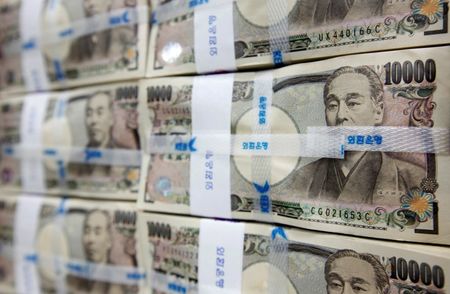

Investing.com– Most Asian currencies have been largely unchanged on Wednesday, whereas the Japanese yen firmed in opposition to the greenback as markets have been frightened concerning the implications of recent tariffs underneath incoming U.S. President Donald Trump.
The greenback retreated barely as focus turned to essential financial information from the world’s largest financial system for extra cues on rates of interest.
On Tuesday, Trump renewed his vow to impose sweeping tariffs on Chinese language imports, promising a ten% further tariff on all items from China and 25% tariffs on merchandise from Mexico and Canada. This vow has reignited fears of a world commerce battle, with dire implications for Asian economies which might be closely reliant on commerce.
The edged decrease in Asian commerce, after gaining within the earlier session. additionally ticked down.
The Chinese language yuan continued to stay underneath stress on Wednesday, with the onshore yuan’s pair rising 0.1% and hovering close to a four-month excessive. The pair had risen 0.2% within the earlier session.
Different regional currencies have been additionally underneath stress as considerations over world financial development and commerce friction weighed on sentiment.
The Singapore greenback’s pair rose marginally, and the Thai baht’s pair fell 0.1%.
The Australian greenback’s pair was flat following blended , which confirmed headline inflation remained regular whereas underlying inflation rose in October.
The Japanese yen’s pair fell 0.5% as merchants sought safe-haven property amid renewed commerce tensions, whereas the Indian rupee’s pair edged up 0.1%, remaining near current report highs.
In the meantime, the New Zealand greenback’s pair rebounded from multi-month lows with a 0.5% rise, after the nation’s central financial institution reduce by 50 foundation factors and signaled additional easing early subsequent yr, citing subdued home financial exercise and waning inflationary pressures.
Markets await U.S. information for cues on Fed’s charge outlook
Market focus was now on information, due afterward Wednesday. The studying is the Federal Reserve’s most well-liked inflation gauge, and comes after the of the central financial institution’s November assembly confirmed policymakers cut up over plans for future charge cuts.
A revised studying on third-quarter U.S. information can also be due later within the day.
Latest indicators of resilience within the U.S. financial system spurred some doubts over simply how a lot impetus the Fed has to maintain reducing rates of interest quickly. Merchants have been seen paring some bets that the Fed will reduce charges in December, particularly after robust inflation readings for October.
Whereas a possible charge reduce by the Fed might provide some reduction to rising markets, any indicators of persistent inflation or slower charge easing are prone to stress Asian currencies.
Trump’s tariff vow rattles trade-driven currencies
The Malaysian ringgit’s pair fell 0.2%, whereas the South Korean received’s , and the Philippine peso’s pairs have been largely unchanged.
Rising market currencies, significantly these with excessive commerce publicity to China, are feeling the pressure. The Malaysian ringgit, Thai baht, and South Korean received have all weakened, with the ringgit and baht falling by round 2% since Trump’s electoral victory on November 5. These currencies, together with others just like the Indian rupee and the Philippine peso, are susceptible to the ripple results of upper tariffs, as trade-reliant economies are prone to bear the brunt of any U.S. actions.
International locations like South Korea and Singapore, which have robust commerce ties to the U.S. and China, might see their currencies proceed to weaken if the tariffs are imposed. Analysts count on these developments to problem the soundness of Asian currencies within the coming months, as traders hedge in opposition to the potential fallout from a revived U.S.-China commerce battle.